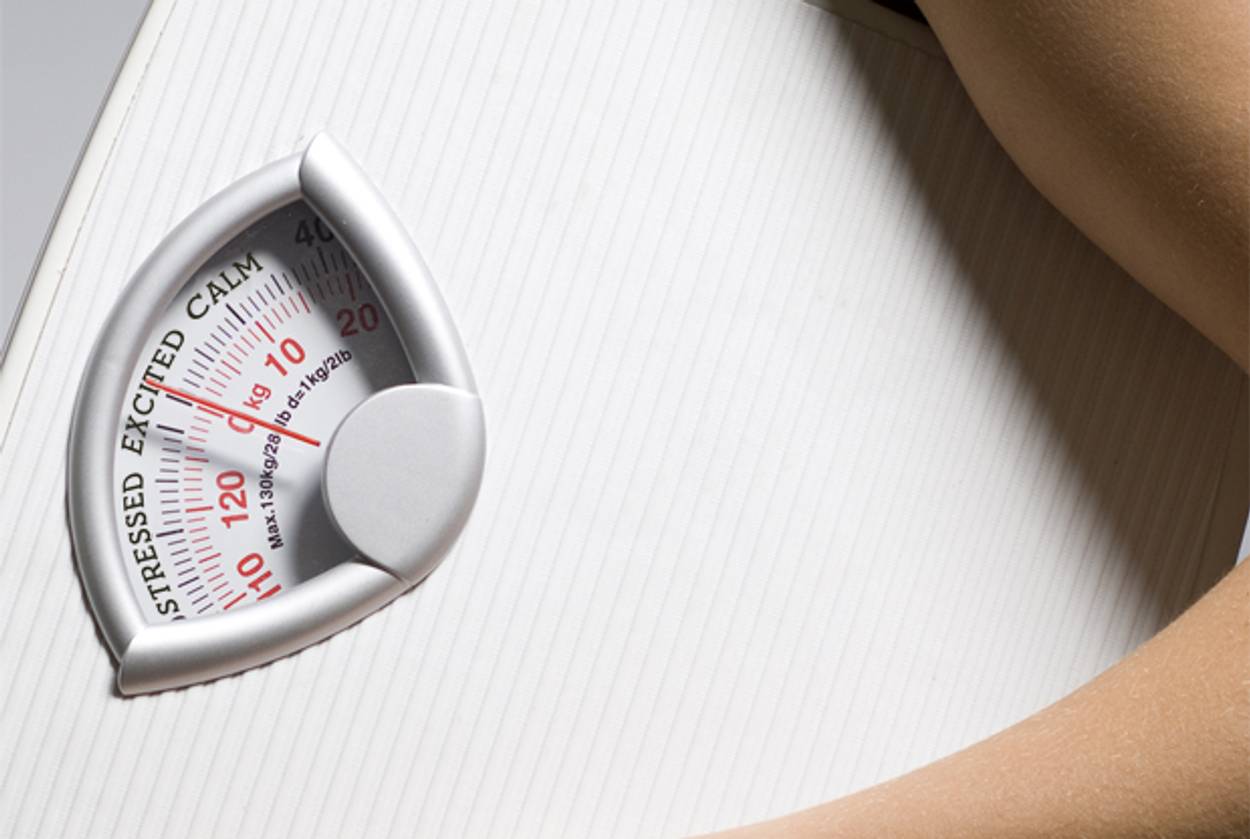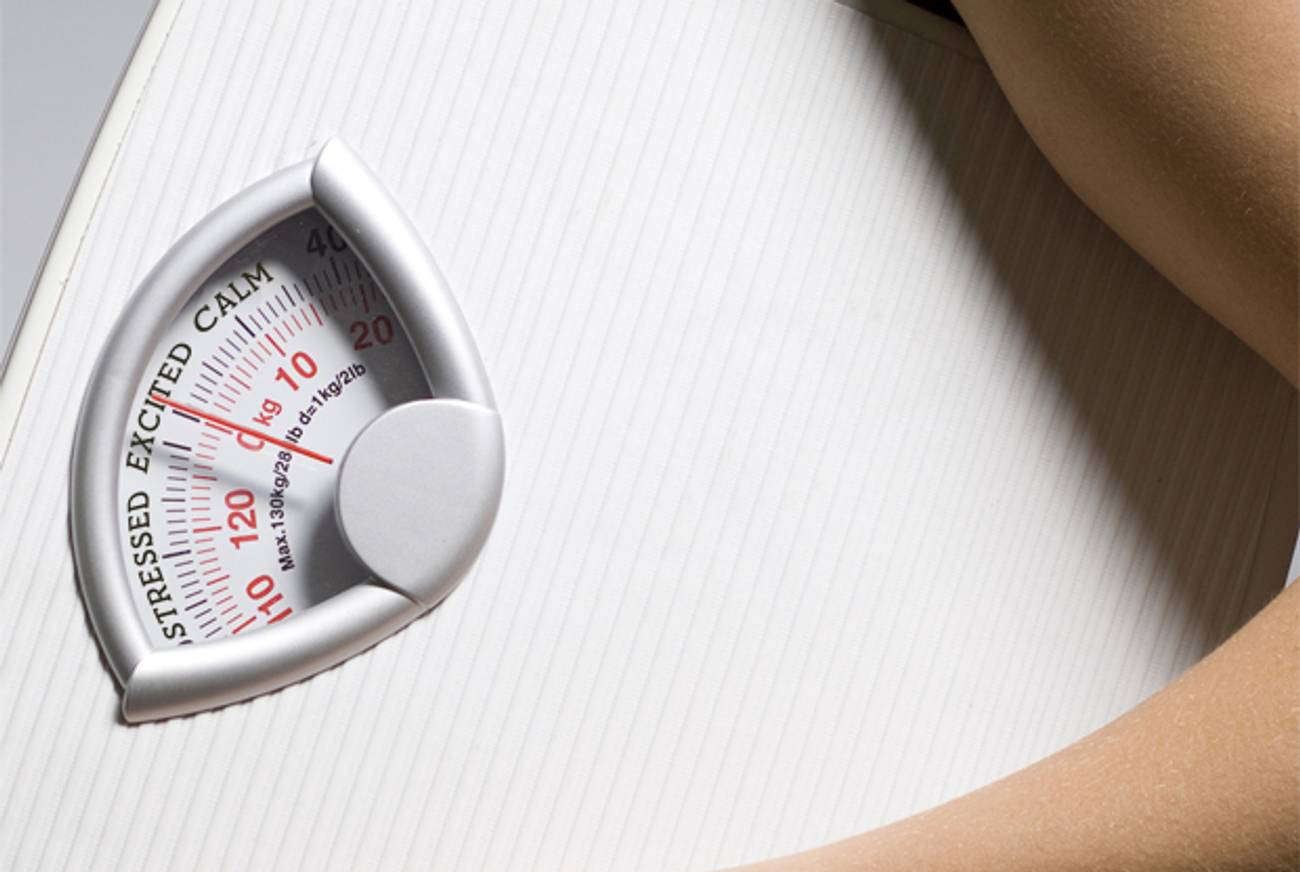My Spiritual Fitness Regimen
Instead of focusing on dieting before my daughter’s bat mitzvah, I decided to get in shape emotionally




I dieted for my wedding. A month before the nuptials, I spotted a tree with a flyer that read “Lose twenty pounds in a month.” I donned my Ray-Bans and discreetly tore the tag from the bottom of the poster. I made the call from a pay phone—this was 16 years ago, before everyone used cell phones—and I set up a rendezvous in a drugstore parking lot. The man who showed up drove an old Jetta and reminded me of a fugitive featured in a story I’d recently produced for America’s Most Wanted. I gave him an envelope of cash in exchange for his protein packets, which I would mix into my fat-free Dannon yogurts for the next month. The diet made me wired, ravenous, and so irritable that I screamed at my fiancé for having the audacity to buy me the wrong flavored yogurt and other such minor transgressions. But it worked: I lost a dozen pounds and achieved my noble goal of memorializing my college size-eightness in my wedding photos.
That pre-wedding ritual is what I call a life-cycle-moment diet: a reduction of calories, perhaps driven or augmented by a commercial weight-loss plan that could involve powders, shakes, food diaries, and meetings with other dieters who sit in blue chairs and celebrate or lament the results of their weekly weigh-ins—all done with a specific deadline pegged to an upcoming rite of passage.
Last fall, I toyed with the idea of doing a similar diet leading up to my daughter’s bat mitzvah, which we celebrated last month. A few friends were melting off weight via belly-blasting regimens. They tempted me with their accounts of new energy, clear-headedness, and steady satiety. But I thought back on how I’d felt before my wedding: a bundle of nerves, leaking my inner toxins on my matron of honor and sparking emotional brushfires with other guests that took months to put out. The weight loss, I decided, wasn’t worth the emotional turmoil. This time, I did not diet for my daughter’s bat mitzvah. Instead, I set a new goal: spiritual fitness.
Rather than distracting myself with vitamin shakes and obsessive scale-monitoring, I spent the months leading up to the bat mitzvah trying to get “in shape” mentally and spiritually. I’d perused enough beauty magazines to know that every credible program includes five easy steps. Here are mine—but they weren’t as easy as they sound.
1. Clear the path to the bimah. I knew from our wedding planning that life-cycle events produce emotional static cling that adheres to seemingly innocent conversations about balloon vendors, tablecloths, and seating arrangements. To prevent this electricity from zapping my daughter’s bat mitzvah, my husband and I tackled many tough underlying issues as they surfaced, starting with the guest list. Are we still friends with the so and so’s? Why not? We decided to invite only the friends who had sustained relationships with our daughter, who knew her and mattered to her, as well as every logical member of our ever-shrinking extended family. Some friends and relatives had drifted too far from our lives, and we let them go, with the hope that they might come back and the acceptance that they might not. Because we’d had these discussions in advance, we treasured the presence of every single person who shared our simcha; there was no emotional baggage for our daughter to stumble over on her way to the bimah.
2. Don blinders. A wise veteran of bat mitzvah-planning instructed me to “put on blinders and focus exclusively on the fact that this day is about [your] daughter and God.” I repeated this mantra to myself and anyone who would listen as often as I could. I flipped up those blinders when I started to stress out about snowstorms, power outages, the flu, and anything else that could wipe out an entire guest list. The only vital personnel for the ceremony were my daughter and the rabbi, I reminded myself. Anyone else who showed up was gravy.
3. Ask for help. I am as jealous as I am in awe of people who ask for help, who admit that they aren’t perfect and accept the limitations of friends and family who offer support and in turn feel a part of their joy and sorrow. I asked for help from the friends who knew to remind me about those blinders, and I asked for assistance in hosting an unexpected Shabbat dinner in my home. Lemon bars and coleslaw were prepared, napkins folded, chicken heated up while we attended services, and dishes miraculously washed after the meal.
4. Show gratitude. Whenever a petty gripe bubbled up inside of me, I replaced it with an expression of gratitude: gratitude for my parents’ health and love, the friend who hosted our daughter’s shomer Shabbos tutor so that she could participate in our simcha, my daughter’s friends who honored her with beautiful words and collages, my little boy’s enthusiasm, the people who went to great lengths to show up, and our cantor who sat quietly next to my daughter before the ceremony and seemed to hold her jitters in his hand. The list goes on.
5. Pray. My spiritual fitness program stretched me in ways that made me uncomfortable, like wearing someone else’s contact lenses or parachuting out of an airplane or sprinting at the end of a long run. My muscle, in this case my heart, felt sore before it grew stronger. So I prayed. I prayed for the usual things—health, the cure for all illnesses, and reversal of global warming—as well as the humility to pull off points 1 through 4 and the strength to resist the insanity of life-cycle-moment dieting. I was a novice at praying, so for pointers I read and reread Ann Lamott’s Help, Thanks, Wow.
I did not create this spiritual-fitness regimen alone. It was born out of conversations with my husband and a few lovely souls, some of whom have since adapted their own versions of this program. They continue to remind me that like any fitness program, this one only works if you work hard. Every single day. I confess to periodically reverting back to my old ungrateful, critical self, my words tasting like the first bite of a greasy pizza after a detox cleans: pretty delicious. Yet one bite will beget another and another, followed by a bellyache, if I don’t hit what Ann Lamott calls the “reset” button, pronto.
Two weeks after the simcha, the photographer sent us his proofs. My face looks round and my triceps are mushy and for a split second, I wished I’d succumbed to a life-cycle-moment diet. Then I pounded the reset button. I knew I’d chosen the right fitness plan when I saw what else is evident in the photos: Joy radiates from every pixel. Pure, high-voltage love beams down the unfettered path to the bimah. Our community sways to the Havdalah prayer my daughter leads, her soft voice flowing around and then through us, before rising into the night.
***
Like this article? Sign up for our Daily Digest to get Tablet Magazine’s new content in your inbox each morning.
Michelle Brafman teaches fiction writing at The Johns Hopkins MA in Writing Program and George Washington University and recently completed a novel about Jewish burial rituals.
Michelle Brafman teaches fiction writing at The Johns Hopkins MA in Writing Program and George Washington University and recently completed a novel about Jewish burial rituals.